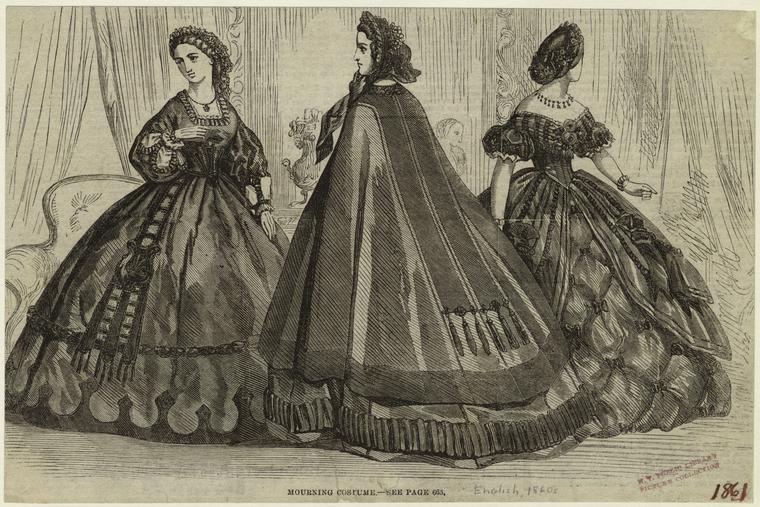Before I could write Wedded to War, I not only had to learn Civil War history, but what everyday life was like for women in the Victorian age. What did they eat? What did they do for fun? What did they wear? This last question was one of the most fascinating to find answers for. I am indebted to costume historian Tom Tierney for creating his Civil War Fashions Coloring Book and American Family of the Civil War Era paper dolls, both of which offer extremely detailed illustrations and captions of the fashions my characters in Wedded to War would have worn.
Three elements of Civil War fashion are especially interesting to me, however, and I hope they will interest you as well: corsets, hoop skirts, and mourning dress.
The Corset
Virtually every woman wore a corset of some type under their clothing, from working class women to domestic servants to genteel ladies of society. The ideal was a waist of 15 inches, but corsets did come in different sizes so we know that not everyone squeezed themselves to match this standard. Corsets were stiffened with whalebone, steel, or even oak splits for women in the South during the war.
Most corsets closed in the front with metal brads and eyelets, and more rarely they laced up the back with hooks and eyes. Women whose corsets laced up the back would have needed help dressing. During the Victorian Age, including the Civil War, a tightly laced corset was widely associated with a woman’s virtue. In fact, many terms we use today to describe someone’s morality come from this association: “The allusion to loosening one’s stays [corsets] as a prelude to sexual activity permeated everyday life, so that women who were called “loose” were not being described physically so much as morally. Other terms that were used to describe behavior were very closely linked to costume and appearance. “Terms such as “upright,” “restrained,” or “upstanding” certainly describe a corseted woman’s physical appearance as well as her reputation just as “unbridled,” “unrestrained,” and “loose” were epithets linked to appearance. . . .The woman’s body was to be constrained within appropriate undergarments that were to be taken off only in privacy or within the confines of the marriage bedroom. Sarah Hale, editor of Godey’s Lady’s Book, as well as author of several books covering etiquette, considered a woman’s clothing to be an effective indication of her morality, and the corset was a requisite part of that appearance.”1
The Hoop Skirt
The women’s fashion feature most associated with the Civil War era is the hoop skirt, named for the structural support of wire hoops or whalebones called “crinolines,” worn under the skirt to hold its shape. In a typical dress, the width of the skirt at its widest point (which was close to the floor) was about 50 to 70 percent of the woman’s height.2 In formal gowns, such as those worn by First Lady Mary Lincoln, the skirt was up to eighteen feet in circumference, using twenty-five yards of fabric.3  Many women saw the crinoline as an improvement over the weight and cumbersomeness of wearing multiple petticoats—and there was less laundry, but hoop skirts posed other challenges. Sometimes the skirts tilted up on one side, exposing views of legs and undergarments, and they could catch on fire if women stood too close to fireplaces.
Many women saw the crinoline as an improvement over the weight and cumbersomeness of wearing multiple petticoats—and there was less laundry, but hoop skirts posed other challenges. Sometimes the skirts tilted up on one side, exposing views of legs and undergarments, and they could catch on fire if women stood too close to fireplaces.
The wide girth kept men at a distance and filled rooms and stage coaches quickly. New York omnibuses charged higher fares for women with hoops.4 Critics of the hoop skirt were many. A popular song of the times jibed:
Now crinoline is all the rage
with ladies of whatever age,
A petticoat made like a cage—
oh, what a ridiculous fashion!
‘Tis formed of hoops and bars of steel,
or tubes of air which lighter feel,
And worn by girls to be genteel,
or if they’ve figures to conceal.
It makes the dresses stretch far out
a dozen yards or so about,
And please both the thin and stout—
oh, what a ridiculous fashion!5
Civil War nurses did not wear hoops under their dresses due to safety, convenience, and hospital or Sanitary Commission regulations. The hoop skirts were of great use, however, for those wishing to conceal valuable property. Refugees carried bags of silverware or money, runaway slaves carried an extra change of clothes, and daring women smuggled army supplies such as boots through enemy lines—all by attaching them to their crinolines. By 1865, the rage for crinoline began to recede.
Mourning Dress
Death touched the hundreds of thousands of families during the Civil War, and the women put on mourning attire according to their stage of grief.
The period of mourning varied according to the relationship with the deceased. A widow was expected to wear deep mourning for at least one year. This included bombazine (dull, lusterless black) fabric, widow’s cap, black cuffs and collars, and black crepe. Black petticoats, stockings and parasols were also required. During the second stage of mourning (from twelve months to eighteen months after the death), the widow could trade silk or wool for the bombazine and add jet black jewelry and ribbons to her attire. The third stage of mourning commenced at eighteen months after the death, and allowed the half-mourning colors of grey, purple, mauve, lavender, or black and grey in her dress.
A daughter’s rules for a parent’s death were less stringent. She needed to only were black for six months, then two months of half-mourning colors. Corsets, hoops, and mourning dress were integral to women during the Civil War, and can be found in the characters of Wedded to War.
(For photographs of women's fashions worn in the Civil War, visit my Civil War Women's Fashion Pinterest board here (link is external).)
And if you're into historical fiction, check out Wedded to War and my other Civil War novels. What other elements of historical fashion fascinate you?
Sources 1. Stamper, Anita A. and Jill Condra. Clothing through American history: the Civil War through the Gilded Age, 1861-1899. Westport, CT: Greenwood, 2010. Page 109.
2. Leisch, Juanita. Who Wore What? Women’s Wear 1861-1865. Gettysburg, PA: Thomas Publications, 1995. Page 70.
3. Rutberg, B. Mary Lincoln’s Dressmaker. New York: Walker and Company, 1995. Pg 40.
4. Ibid.
5. Hoffman, Frank, and William Bailey. Fashion and Merchandising Fads. New York: Routledge, 1994. Page 115.




Add new comment